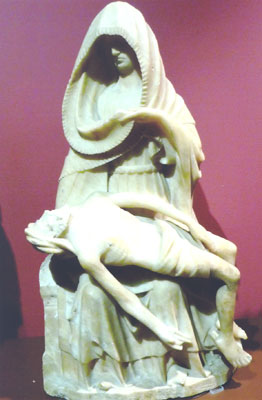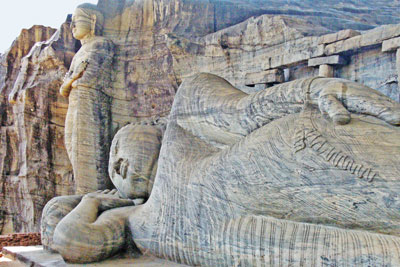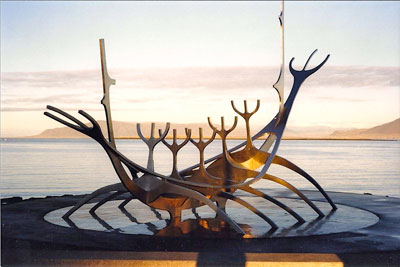Captivating art
In the course of your travels, what work of art took you by surprise in that it affected you deeply in some way? Which one lingered in your memory for some reason or made you long to see it again? That’s what we asked recently, and many of you responded, as shown below.
Guidelines were given — the piece doesn’t have to be something famous, but you do need to be able to state what it was (either a title or an adequate description) and where you saw it, so that others may find it. Name the artist, if possible. And include approximately when you viewed the work. Lastly, describe the item or artwork and try to tell what it was about it that struck you and left an impression.
If a painting, sculpture or other visual work of an artist (excluding great architecture — no buildings, themselves) has come to mind, write to Captivating Art, c/o ITN, 2116 28th St., Sacramento, CA 95818, or e-mail editor@intltravelnews.com. Include the address at which you receive ITN. More responses will be printed in the next issue.
Rembrandt’s “The Return of the Prodigal Son,” in ST. PETERSBURG at the Hermitage Museum (2, Dvortsovaya Ploshchad, 190000, St. Petersburg, Russia; phone [812] 710 90 79), is the most moving and memorable piece of art, for me. I spent hours pondering this painting during six visits to Leningrad/St. Petersburg from 1963 to 2004.
You need to visit this masterpiece late in the afternoon after all the cruise-ship crowds have left and the gallery is quiet, so you can gaze at the details, especially the facial expressions, the hands, and the tears in the eyes of the old father reunited with his repentant son.
Kathy Whitmer
Bellingham, WA
I have seen all of Michelangelo’s “Pietas” and I don’t know how many thousands of others (including some in small chapels on the pilgrims’ walk to Santiago de Compostela). None has hit me harder than the “Pieta” I happened upon in GUIMARÃES, Portugal, in 2005 at the Museu de Alberto Sampaio (Rua de Alfredo Guimarães, 4800-407 Guimarães; phone 253 423 910).
It was sculpted by an unknown 15th-century artist and came from Nottingham, England. (Go figure!) Made of marble and standing about 12 to 15 inches tall, it captures the sorrow and mystery of life and death so simply and so poignantly that it will haunt you forever.
In 2010 I returned to Guimarães with my wife so she could experience the same emotions. She did.
Dick Walker
La Jolla, CA
The piece of art which will always linger in my memory is “Jäger im Schnee,” or “Hunters in the Snow,” by Pieter Bruegel the Elder, housed with other Bruegels on the first floor of the Kunsthistorisches Museum (Maria Theresien-Platz, 1010 VIENNA, Austria).
I usually run the other way when it comes to guided tours in museums, but on our December ’01 trip with Interhostel, our very able guide, Reiner Lefevre, began his tour with the room full of huge Bruegels and my husband and I thought we’d stick around for just this part. We didn’t regret it.
Reiner spent an hour lecturing on the obvious and not-so-obvious features of the very large paintings in Bruegel’s series on the seasons. Of all the paintings, I thought that “Hunters” was the most outstanding. I’d seen copies of it in art books and in art history courses but was not prepared for the impact of the painting up close and personal.
Why was I drawn to the painting? It was the sense of quiet and return in the midst of the busy-ness of the other Bruegels and the Baroque feeling of the entire museum. It was the wonderful perspective, the people in the painting and also the fact that we were in snow-covered Vienna at Christmastime.
Later, I purchased a small book from the museum shop which included reproductions of 100 masterpieces in the museum’s collections. Guess what was on the cover?!
I will always remember this part of that magical vacation in a beautiful place at a wonderful time of year.
Gladys Sheldon
Albuquerque, NM
I was in Vienna’s Kunsthistorisches Museum, or Museum of Art History, well over 20 years ago. I particularly enjoyed the numerous paintings by Pieter Bruegel and his son, which feature countless individuals doing things relating to the theme. Thus the winter one has people sledding, skating, throwing snow, etc. These are truly masterpieces I would enjoy viewing again.
Philip H. de Turk
Pinehurst, NC
Upon reading the question, I immediately recalled seeing Rembrandt’s “The Night Watch” in the Rijksmuseum (Jan Luijkenstraat 1, 1071 CJ AMSTERDAM, The Netherlands) during a bicycle tour of Europe in 1953.
I strolled into a room and was astounded to see this wall-to-wall Baroque depiction. It was as if I could carry on a conversation with the gentlemen pictured.
My second favorite would be the historic religious depiction “Last Supper” at the church Santa Maria delle Grazie (Piazza Santa Maria delle Grazia 2, Milan, Italy). Of course, I had previously seen reproductions of the painting, so it wasn’t so startling.
Cy Donaldson
Castro Valley, CA
On my first trip to AMSTERDAM in April ’03, I saw the beautiful Rembrandt painting “The Night Watch.” While I had seen reproductions and knew it was a very large painting, I was still stunned at the size. It was so beautifully amazing.
Then, on another visit to Amsterdam, in November ’06, while heading from the zoo to the floating flower market I came across a small park with larger-than-life bronze sculptures* of the figures in “The Night Watch,” arranged as in the painting. At a small café across the road, I bought a coffee, then sat and enjoyed the sculptures on that lovely spring afternoon.
I understand that the city was responsible for funding the display, and at that time it was not known how long they would be available for public viewing. I hope they are still there.
Linda Milam
Idaho Falls, ID
*The park is the Rembrandtplein in central Amsterdam. The 22 bronze statues called “The Night Watch 3D,” created by Mikhail Dronov and Alexander Taratynov, have periodically been on display but at press time were not.
Salvador Dalí is not everyone’s cup of tea, but when I saw his painting “Le visage de la guerre,” or “The Face of War” (1940), in ROTTERDAM in 1983, I couldn’t forget it. A huge skull with snakes for hair and other skulls within skulls in the eye and mouth sockets — truly the face of war!
The size is that of a US-type poster, or about two feet by three feet. It is still hung at the Museum Boijmans Van Beuningen (Museumpark 18-20, 3015 CX Rotterdam, The Netherlands; phone +31 [0] 10 44 19 400).
I remember it still after all these years because it seemed to me to be the perfect representation of war — the deaths of so many people.
Linda Beuret
Santa Barbara, CA
One of the highlights of my trip to Sri Lanka with Bestway Tours & Safaris in October ’10 was the tour of the ancient city of POLONNARUWA, one of the island nation’s six UNESCO World Cultural Heritage Sites and located in the north-central part of the country.
Even the impressive color photographs in the travel literature didn’t prepare me for the sculptures in the northern section of that vast archaeological site. The Gal Vihara, or Stone Shrine, also referred to as the Kalugal Vihara, or Black Stone Shrine, comprises four colossal, magnificent, rock-cut images carved out of an enormous outcropping of granite. They are reputed to have been created in the 12th century by King Parakramabahu I.
Two of the colossal figures depict the Buddha seated in the meditative lotus pose. The larger image, measuring 4.6 meters in height, sits under an arch, with smaller carvings of the Buddha looking down from celestial temples. The smaller image of the Buddha, 1.2 meters in height, is now in a carved recess closed off by a metal grille.
The most famous carving at the Gal Vihara is the reclining Buddha, measuring 14 meters (46 feet) in length and depicting him in parinirvana, or death. It is one of Sri Lanka’s most iconic images and is also among the largest images of Buddha in Southeast Asia.
A standing figure, nearly seven meters in height, is the most controversial. Many scholars maintain that it is not a depiction of the Buddha at all. With its arms crossed across its chest (a highly unusual gesture for a representation of the Buddha), it may be an image of a disciple of the Buddha, Ananda, whose sad expression depicts grief at the parinirvana of the Buddha.
The magnificent Buddhist figures at the Gal Vihara are considered among the supreme masterworks of ancient Sinhalese art, but what impressed me the most was their aura of serene and peaceful spirituality. Being privileged to see them in their passive and meditative poses did much to make my visit to Sri Lanka one of my best trips ever.
David J. Patten
Saint Petersburg, FL
The works of art that captivate me most are those that are contained in their original locations. Some of my favorites include the Byzantine mosaics at the Chora Church (Kariye Kamii) in ISTANBUL, Turkey; the Giotto frescoes in PADUA, Italy, and the tomb paintings in SAQQARA, Egypt.
But my favorite place in the whole world is the Villa of the Mysteries in POMPEII, Italy.
On book covers, as exemplars of Roman art, as souvenirs throughout Italy and even as decoration in electronics stores in California, you see the images everywhere — a servant holding a dish and staring at the viewer, and a woman pulling a robe/cape over her head in apparent fright — but there’s nothing like seeing them on site in Pompeii.
They are elements of a series of frescoes on the walls of a triclinium (dining room). In a room measuring about 15 by 25 feet, these frescoes are probably eight to ten feet tall and cover the upper two-thirds of three of the walls. The entire sequence is perhaps 50 feet long.
I was impressed by the quality of the paintings and the brightness of the colors for something that’s 2,000 years old. The facial expressions, the rendering of fabrics and the ability to tell a story (one that we really do not understand) is amazing.
Not only is this great art, the continuing sense of mystery is a huge part of their appeal. “Why are they there? What is the ritual being shown? What is that hidden object behind the (painted) curtain, and what is its role in the ceremony? What was in the missing section?”
I look at these in awe, marveling at their power nearly two millennia after their creation.
David Emery
Reston, VA
I visited PADUA in October ’08, and the most beautiful artworks I saw were the Giotto frescoes in the Scrovegni Chapel (Padua, Italy; phone 0039 049 2010020).
Panels encircling the inside of the chapel depict the lives of Jesus and Mary. I spent a great deal of time absorbing the beauty of it all. The quality of the artwork is astounding, and the frescoes are better preserved than Giotto’s frescoes in Assisi at the Basilica of St. Francis (Piazza S. Francesco, 2, 06081 Assisi, Italy; phone +39 075 819 0084).
Theresa Egan
Odenton, MD
The waterfront in REYKJAVIK, Iceland, is home to “Sólfar,” or “The Sun Voyager,” a steel sculpture by Jón Gunnar Árnason (1931-1989). Our first view of it, in January ’02, was from about 100 yards away when the setting sun was reflecting on the sculpture and offering a sense of its dramatic beauty.
Our initial impression — as we approached the sculpture while coming down a hilly street — was of a Viking ship landing and men ready to disembark. We felt as if we had a sense of what it must have been like to encounter marauding (or trading) Vikings arriving unexpectedly on one’s shore.
We visited “Sun Voyager” again in March ’07 and continued to be touched by the emotional impact and beauty of the work as well as the creative and technical skill of the artist.
Marisue Pickering
Orono, ME
As a graduate student doing research in Italy, in November of 1974 I went to ASSISI to check out the frescoes, particularly those in the Lower Church of the Basilica of San Francesco d’Assisi. I was most interested to see, in the Chapel of St. Martin, the frescoes of my favorite Sienese artist, Simone Martini (died c. 1344 in Avignon).
When I arrived at the basilica, I discovered that the chapel I was most interested in was full of scaffolding. A Roman équipe (team) was hard at work restoring the frescoes. I introduced myself and was enthusiastically encouraged to go up to the vault to view the remarkable discovery they had made.
There, 30 feet above the floor, in a location normally in total darkness, Simone had incised a floral design into the wet plaster of the vault ribs and then had gilded them.
Simone could not have expected anyone to see his work up there. He apparently did it because he loved beautiful things and took immense pride in his work. (If you wish to see what I saw, take a strong flashlight).
I’ll never forget that day.
Ann Brown
Woodland, CA



